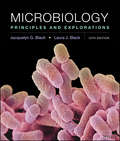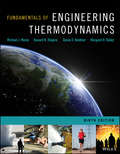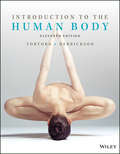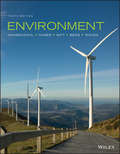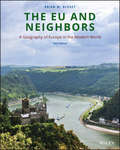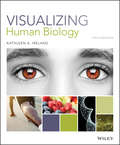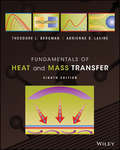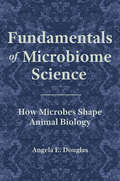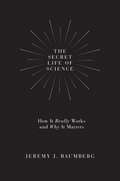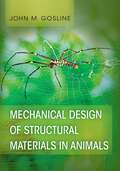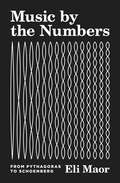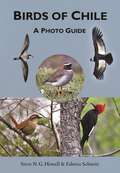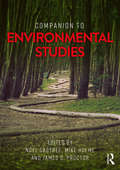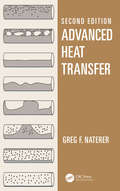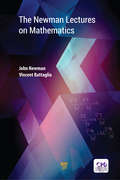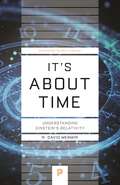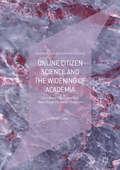- Table View
- List View
Microbiology: Principles and Explorations (Wiley Plus Products Ser.)
by Jacquelyn G. Black Laura J. BlackMicrobiology: Principles and Explorations is an introductory product that has successfully educated thousands of students on the beginning principles of Microbiology. Using a student-friendly approach, this product carefully guides students through all of the basics and prepares them for more advanced studies.
Fundamentals of Engineering Thermodynamics, Enhanced eText: Student Problem Set Supplement
by Michael J. Moran Howard N. Shapiro Daisie D. Boettner Margaret B. BaileyFundamentals of Engineering Thermodynamics sets the standard for teaching students how to be effective problem solvers. Integrated throughout this product are real-world applications that emphasize the relevance of thermodynamic principles to some of the most critical problems and issues of today. These include a wealth of coverage on topics related to energy and the environment, biomedical/bioengineering, and emerging technologies.
Introduction to the Human Body: The Essentials Of Anatomy And Physiology (Wiley Plus Products Ser.)
by Gerard J. Tortora Bryan H. DerricksonIntroduction to the Human Body combines exceptional content and outstanding visual, auditory, and interactive presentations for a multimodal and comprehensive learning experience. This digital course gives students the ability to learn and explore anatomy and physiology both inside and outside of the classroom.
Environment, Enhanced eText
by Linda R. Berg Peter H. Raven David M. Hassenzahl Mary Catherine Hager Nancy Y. GiftEnvironment, Tenth Edition helps students understand the connection between the core concepts of the Environmental Science and their daily lives. The 10th edition enhanced e-text features a rich, interactive collection of current case studies and in-text examples, which provides students with the tools to understand, apply, and think critically about environmental science. It also provides instructors with powerful tools to assess individual students progresses well as the class as a whole.
The EU and Neighbors: A Geography of Europe in the Modern World
by Brian W. BlouetEurope is the second-smallest of the continents, yet it is the third most populated—and its rich history has played out on the world's maps for centuries. The region's borders have undergone near-continuous evolution through the rise and fall of nations, rebellions, and civilizations, and the paths these borders take have repercussions around the globe. This book presents a systematic survey of Europe and individual country-by-country coverage based on the most current data. From the core of the European Union to the lesser-known corners of the continent, this book provides in-depth examination of the physical, cultural, economic, and political geography of this powerful region. Fresh perspective sheds new light on recent events including Brexit, Russia's takeover of Crimea, terrorist attacks in France, and the EU's newest members, while the European Union's future is explored in light of the possible loss of the region’s second-largest economy. With deep insight into each nation and its relationship to the region, this book offers a uniquely intimate look at the various dynamics shaping Europe today.
Visualizing Human Biology (Visualizing Series)
by Kathleen A. IrelandVisualizing Human Biology is a visual exploration of the major concepts of biology using the human body as the context. Students are engaged in scientific exploration and critical thinking in this product specially designed for non-science majors. Topics covered include an overview of human anatomy and physiology, nutrition, immunity and disease, cancer biology, and genetics. The aim of Visualizing Human Biology is a greater understanding, appreciation and working knowledge of biology as well as an enhanced ability to make healthy choices and informed healthcare decisions.
Fundamentals of Heat and Mass Transfer
by Theodore L. Bergman Adrienne S. LavineFundamentals of Heat and Mass Transfer
Fundamentals of Microbiome Science: How Microbes Shape Animal Biology
by Angela DouglasAn essential introduction to microbiome science, a new cutting-edge discipline that is transforming the life sciencesThis book provides an accessible and authoritative guide to the fundamental principles of microbiome science, an exciting and fast-emerging new discipline that is reshaping many aspects of the life sciences. Resident microbes in healthy animals--including humans—can dictate many traits of the animal host. This animal microbiome is a second immune system conferring protection against pathogens; it can structure host metabolism in animals as diverse as reef corals and hibernating mammals; and it may influence animal behavior, from social recognition to emotional states. These microbial partners can also drive ecologically important traits, from thermal tolerance to diet, and have contributed to animal diversification over long evolutionary timescales.Drawing on concepts and data across a broad range of disciplines and systems, Angela Douglas provides a conceptual framework for understanding these animal-microbe interactions while shedding critical light on the scientific challenges that lie ahead. Douglas explains why microbiome science demands creative and interdisciplinary thinking—the capacity to combine microbiology with animal physiology, ecological theory with immunology, and evolutionary perspectives with metabolic science.An essential introduction to a cutting-edge field that is revolutionizing the life sciences, this book explains why microbiome science presents a more complete picture of the biology of humans and other animals, and how it can deliver novel therapies for many medical conditions and new strategies for pest control.
The Secret Life of Science: How It Really Works and Why It Matters
by Jeremy BaumbergA revealing and provocative look at the current state of global scienceWe take the advance of science as given. But how does science really work? Is it truly as healthy as we tend to think? How does the system itself shape what scientists do? The Secret Life of Science takes a clear-eyed and provocative look at the current state of global science, shedding light on a cutthroat and tightly tensioned enterprise that even scientists themselves often don't fully understand.The Secret Life of Science is a dispatch from the front lines of modern science. It paints a startling picture of a complex scientific ecosystem that has become the most competitive free-market environment on the planet. It reveals how big this ecosystem really is, what motivates its participants, and who reaps the rewards. Are there too few scientists in the world or too many? Are some fields expanding at the expense of others? What science is shared or published, and who determines what the public gets to hear about? What is the future of science? Answering these and other questions, this controversial book explains why globalization is not necessarily good for science, nor is the continued growth in the number of scientists. It portrays a scientific community engaged in a race for limited resources that determines whether careers are lost or won, whose research visions become the mainstream, and whose vested interests end up in control.The Secret Life of Science explains why this hypercompetitive environment is stifling the diversity of research and the resiliency of science itself, and why new ideas are needed to ensure that the scientific enterprise remains healthy and vibrant.
The Secret Life of Science: How It Really Works and Why It Matters
by Jeremy BaumbergA revealing and provocative look at the current state of global scienceWe take the advance of science as given. But how does science really work? Is it truly as healthy as we tend to think? How does the system itself shape what scientists do? The Secret Life of Science takes a clear-eyed and provocative look at the current state of global science, shedding light on a cutthroat and tightly tensioned enterprise that even scientists themselves often don't fully understand.The Secret Life of Science is a dispatch from the front lines of modern science. It paints a startling picture of a complex scientific ecosystem that has become the most competitive free-market environment on the planet. It reveals how big this ecosystem really is, what motivates its participants, and who reaps the rewards. Are there too few scientists in the world or too many? Are some fields expanding at the expense of others? What science is shared or published, and who determines what the public gets to hear about? What is the future of science? Answering these and other questions, this controversial book explains why globalization is not necessarily good for science, nor is the continued growth in the number of scientists. It portrays a scientific community engaged in a race for limited resources that determines whether careers are lost or won, whose research visions become the mainstream, and whose vested interests end up in control.The Secret Life of Science explains why this hypercompetitive environment is stifling the diversity of research and the resiliency of science itself, and why new ideas are needed to ensure that the scientific enterprise remains healthy and vibrant.
The Secret Life of Science: How It Really Works and Why It Matters
by Jeremy BaumbergA revealing and provocative look at the current state of global scienceWe take the advance of science as given. But how does science really work? Is it truly as healthy as we tend to think? How does the system itself shape what scientists do? The Secret Life of Science takes a clear-eyed and provocative look at the current state of global science, shedding light on a cutthroat and tightly tensioned enterprise that even scientists themselves often don't fully understand.The Secret Life of Science is a dispatch from the front lines of modern science. It paints a startling picture of a complex scientific ecosystem that has become the most competitive free-market environment on the planet. It reveals how big this ecosystem really is, what motivates its participants, and who reaps the rewards. Are there too few scientists in the world or too many? Are some fields expanding at the expense of others? What science is shared or published, and who determines what the public gets to hear about? What is the future of science? Answering these and other questions, this controversial book explains why globalization is not necessarily good for science, nor is the continued growth in the number of scientists. It portrays a scientific community engaged in a race for limited resources that determines whether careers are lost or won, whose research visions become the mainstream, and whose vested interests end up in control.The Secret Life of Science explains why this hypercompetitive environment is stifling the diversity of research and the resiliency of science itself, and why new ideas are needed to ensure that the scientific enterprise remains healthy and vibrant.
Fundamentals of Microbiome Science: How Microbes Shape Animal Biology
by Angela DouglasAn essential introduction to microbiome science, a new cutting-edge discipline that is transforming the life sciencesThis book provides an accessible and authoritative guide to the fundamental principles of microbiome science, an exciting and fast-emerging new discipline that is reshaping many aspects of the life sciences. Resident microbes in healthy animals--including humans—can dictate many traits of the animal host. This animal microbiome is a second immune system conferring protection against pathogens; it can structure host metabolism in animals as diverse as reef corals and hibernating mammals; and it may influence animal behavior, from social recognition to emotional states. These microbial partners can also drive ecologically important traits, from thermal tolerance to diet, and have contributed to animal diversification over long evolutionary timescales.Drawing on concepts and data across a broad range of disciplines and systems, Angela Douglas provides a conceptual framework for understanding these animal-microbe interactions while shedding critical light on the scientific challenges that lie ahead. Douglas explains why microbiome science demands creative and interdisciplinary thinking—the capacity to combine microbiology with animal physiology, ecological theory with immunology, and evolutionary perspectives with metabolic science.An essential introduction to a cutting-edge field that is revolutionizing the life sciences, this book explains why microbiome science presents a more complete picture of the biology of humans and other animals, and how it can deliver novel therapies for many medical conditions and new strategies for pest control.
Fundamentals of Microbiome Science: How Microbes Shape Animal Biology
by Angela DouglasAn essential introduction to microbiome science, a new cutting-edge discipline that is transforming the life sciencesThis book provides an accessible and authoritative guide to the fundamental principles of microbiome science, an exciting and fast-emerging new discipline that is reshaping many aspects of the life sciences. Resident microbes in healthy animals--including humans—can dictate many traits of the animal host. This animal microbiome is a second immune system conferring protection against pathogens; it can structure host metabolism in animals as diverse as reef corals and hibernating mammals; and it may influence animal behavior, from social recognition to emotional states. These microbial partners can also drive ecologically important traits, from thermal tolerance to diet, and have contributed to animal diversification over long evolutionary timescales.Drawing on concepts and data across a broad range of disciplines and systems, Angela Douglas provides a conceptual framework for understanding these animal-microbe interactions while shedding critical light on the scientific challenges that lie ahead. Douglas explains why microbiome science demands creative and interdisciplinary thinking—the capacity to combine microbiology with animal physiology, ecological theory with immunology, and evolutionary perspectives with metabolic science.An essential introduction to a cutting-edge field that is revolutionizing the life sciences, this book explains why microbiome science presents a more complete picture of the biology of humans and other animals, and how it can deliver novel therapies for many medical conditions and new strategies for pest control.
Mechanical Design of Structural Materials in Animals
by John GoslineMechanical Design of Structural Materials in Animals explores the principles underlying how molecules interact to produce the functional attributes of biological materials: their strength and stiffness, ability to absorb and store energy, and ability to resist the fatigue that accrues through a lifetime of physical insults. These attributes play a central role in determining the size and shape of animals, the ways in which they can move, and how they interact with their environment. By showing how structural materials have been designed by evolution, John Gosline sheds important light on how animals work.Gosline elucidates the pertinent theories for how molecules are arranged into macromolecular structures and how those structures are then built up into whole organisms. In particular, Gosline develops the theory of discontinuous, fiber-reinforced composites, which he employs in a grand synthesis to explain the properties of everything from the body wall of sea anemones to spiders' silks and insect cuticles, tendons, ligaments, and bones. Although the theories are examined in depth, Gosline's elegant discussion makes them accessible to anyone with an interest in the mechanics of life.Focusing on the materials from which animals are constructed, this book answers fundamental questions about mechanical properties in nature.
Music by the Numbers: From Pythagoras to Schoenberg
by Eli MaorHow music has influenced mathematics, physics, and astronomy from ancient Greece to the twentieth centuryMusic is filled with mathematical elements, the works of Bach are often said to possess a math-like logic, and Igor Stravinsky said "musical form is close to mathematics," while Arnold Schoenberg, Iannis Xenakis, and Karlheinz Stockhausen went further, writing music explicitly based on mathematical principles. Yet Eli Maor argues that music has influenced math at least as much as math has influenced music. Starting with Pythagoras, proceeding through the work of Schoenberg, and ending with contemporary string theory, Music by the Numbers tells a fascinating story of composers, scientists, inventors, and eccentrics who played a role in the age-old relationship between music, mathematics, and the sciences, especially physics and astronomy. Music by the Numbers explores key moments in this history, particularly how problems originating in music have inspired mathematicians for centuries. Perhaps the most famous of these problems is the vibrating string, which pitted some of the greatest mathematicians of the eighteenth century against each other in a debate that lasted more than fifty years and that eventually led to the development of post-calculus mathematics. Other highlights in the book include a comparison between meter in music and metric in geometry, complete with examples of rhythmic patterns from Bach to Stravinsky, and an exploration of a suggestive twentieth-century development: the nearly simultaneous emergence of Einstein's theory of relativity and Schoenberg's twelve-tone system.Weaving these compelling historical episodes with Maor's personal reflections as a mathematician and lover of classical music, Music by the Numbers will delight anyone who loves mathematics and music.
Birds of Chile: A Photo Guide
by Steve Howell Fabrice SchmittA cutting-edge photographic field guide to the birds of ChileThis is the first modern-style photographic field guide to the birds of Chile, an increasingly popular destination with birders and naturalists. Compact and easy to carry, pack, and use, Birds of Chile is ideal for curious naturalists and experienced birders alike, providing everything anyone needs to identify the birds they see. Clear photographs and brief, facing-page species accounts highlight what to look for and how to quickly identify species. The photos include both close-ups and birds-in-habitat images to further aid real-life identification. An introduction and maps provide an overview of Chile's geographic regions and their distinctive birdlife. Birds of Chile is also a great resource for birding in nearby countries, especially Argentina, Bolivia, and Peru.The first field-friendly photographic guide to the birds of ChileMore than 1,000 real-life photos and brief, facing-page text make bird identification easyOverview and maps describe the distinct bird regions of ChilePerfect for curious naturalists and experienced birders alikeCompact and easy to carry and packAlso a great resource for birding in Argentina, Bolivia, and Peru
Companion to Environmental Studies
by Mike Hulme Noel Castree James D. ProctorCompanion to Environmental Studies presents a comprehensive and interdisciplinary overview of the key issues, debates, concepts, approaches and questions that together define environmental studies today. The intellectually wide-ranging volume covers approaches in environmental science all the way through to humanistic and post-natural perspectives on the biophysical world. Though many academic disciplines have incorporated studying the environment as part of their curriculum, only in recent years has it become central to the social sciences and humanities rather than mainly the geosciences. ‘The environment’ is now a keyword in everything from fisheries science to international relations to philosophical ethics to cultural studies. The Companion brings these subject areas, and their distinctive perspectives and contributions, together in one accessible volume. Over 150 short chapters written by leading international experts provide concise, authoritative and easy-to-use summaries of all the major and emerging topics dominating the field, while the seven part introductions situate and provide context for section entries. A gateway to deeper understanding is provided via further reading and links to online resources. Companion to Environmental Studies offers an essential one-stop reference to university students, academics, policy makers and others keenly interested in ‘the environmental question’, the answer to which will define the coming century.
Advanced Heat Transfer, Second Edition
by Greg F. NatererAdvanced Heat Transfer, Second Edition provides a comprehensive presentation of intermediate and advanced heat transfer, and a unified treatment including both single and multiphase systems. It provides a fresh perspective, with coverage of new emerging fields within heat transfer, such as solar energy and cooling of microelectronics. Conductive, radiative and convective modes of heat transfer are presented, as are phase change modes. Using the latest solutions methods, the text is ideal for the range of engineering majors taking a second-level heat transfer course/module, which enables them to succeed in later coursework in energy systems, combustion, and chemical reaction engineering.
The Newman Lectures on Mathematics
by John Newman Vincent BattagliaProf. Newman is considered one of the great chemical engineers of his time. His reputation derives from his mastery of all phases of the subject matter, his clarity of thought, and his ability to reduce complex problems to their essential core elements. He is a member of the National Academy of Engineering, Washington, DC, USA, and has won numerous national awards including every award offered by the Electrochemical Society, USA. His motto, as known by his colleagues, is "do it right the first time." He has been teaching undergraduate and graduate core subject courses at the University of California, Berkeley (UC Berkeley), USA, since joining the faculty in 1966. His method is to write out, in long form, everything he expects to convey to his class on a subject on any given day. He has maintained and updated his lecture notes from notepad to computer throughout his career. This book is an exact reproduction of those notes. This book shows a clean and concise way on how to use different analytical techniques to solve equations of multiple forms that one is likely to encounter in most engineering fields, especially chemical engineering. It provides the framework for formulating and solving problems in mass transport, fluid dynamics, reaction kinetics, and thermodynamics through ordinary and partial differential equations. It includes topics such as Laplace transforms, Legendre’s equation, vector calculus, Fourier transforms, similarity transforms, coordinate transforms, conformal mapping, variational calculus, superposition integrals, and hyperbolic equations. The simplicity of the presentation instils confidence in the readers that they can solve any problem they come across either analytically or computationally.
Superbugs: An Arms Race against Bacteria
by William HallAntibiotics are powerful drugs that can prevent and treat infections, but they are becoming less effective as a result of drug resistance. Resistance develops because the bacteria that antibiotics target can evolve ways to defend themselves against these drugs. When antibiotics fail, there is very little else to prevent an infection from spreading. Unnecessary use of antibiotics in both humans and animals accelerates the evolution of drug-resistant bacteria, with potentially catastrophic personal and global consequences. Our best defenses against infectious disease could cease to work, surgical procedures would become deadly, and we might return to a world where even small cuts are life-threatening. The problem of drug resistance already kills over one million people across the world every year and has huge economic costs. Without action, this problem will become significantly worse. Following from their work on the Review on Antimicrobial Resistance, William Hall, Anthony McDonnell, and Jim O’Neill outline the major systematic failures that have led to this growing crisis. They also provide a set of solutions to tackle these global issues that governments, industry, and public health specialists can adopt. In addition to personal behavioral modifications, such as better handwashing regimens, Superbugs argues for mounting an offense against this threat through agricultural policy changes, an industrial research stimulus, and other broad-scale economic and social incentives.
Superbugs: An Arms Race against Bacteria (PDF)
by William HallAntibiotics are powerful drugs that can prevent and treat infections, but they are becoming less effective as a result of drug resistance. Resistance develops because the bacteria that antibiotics target can evolve ways to defend themselves against these drugs. When antibiotics fail, there is very little else to prevent an infection from spreading. Unnecessary use of antibiotics in both humans and animals accelerates the evolution of drug-resistant bacteria, with potentially catastrophic personal and global consequences. Our best defenses against infectious disease could cease to work, surgical procedures would become deadly, and we might return to a world where even small cuts are life-threatening. The problem of drug resistance already kills over one million people across the world every year and has huge economic costs. Without action, this problem will become significantly worse. Following from their work on the Review on Antimicrobial Resistance, William Hall, Anthony McDonnell, and Jim O’Neill outline the major systematic failures that have led to this growing crisis. They also provide a set of solutions to tackle these global issues that governments, industry, and public health specialists can adopt. In addition to personal behavioral modifications, such as better handwashing regimens, Superbugs argues for mounting an offense against this threat through agricultural policy changes, an industrial research stimulus, and other broad-scale economic and social incentives.
It's About Time: Understanding Einstein's Relativity
by N. David MerminIn It's About Time, N. David Mermin asserts that relativity ought to be an important part of everyone's education--after all, it is largely about time, a subject with which all are familiar. The book reveals that some of our most intuitive notions about time are shockingly wrong, and that the real nature of time discovered by Einstein can be rigorously explained without advanced mathematics. This readable exposition of the nature of time as addressed in Einstein's theory of relativity is accessible to anyone who remembers a little high school algebra and elementary plane geometry. The book evolved as Mermin taught the subject to diverse groups of undergraduates at Cornell University, none of them science majors, over three and a half decades. Mermin's approach is imaginative, yet accurate and complete. Clear, lively, and informal, the book will appeal to intellectually curious readers of all kinds, including even professional physicists, who will be intrigued by its highly original approach.
It's About Time: Understanding Einstein's Relativity
by N. David MerminIn It's About Time, N. David Mermin asserts that relativity ought to be an important part of everyone's education--after all, it is largely about time, a subject with which all are familiar. The book reveals that some of our most intuitive notions about time are shockingly wrong, and that the real nature of time discovered by Einstein can be rigorously explained without advanced mathematics. This readable exposition of the nature of time as addressed in Einstein's theory of relativity is accessible to anyone who remembers a little high school algebra and elementary plane geometry. The book evolved as Mermin taught the subject to diverse groups of undergraduates at Cornell University, none of them science majors, over three and a half decades. Mermin's approach is imaginative, yet accurate and complete. Clear, lively, and informal, the book will appeal to intellectually curious readers of all kinds, including even professional physicists, who will be intrigued by its highly original approach.
Online Citizen Science and the Widening of Academia: Distributed Engagement with Research and Knowledge Production (Palgrave Studies in Alternative Education)
by Vickie CurtisThis book examines the increasing popularity of online citizen science projects arising from developments in ICT and rapid improvements in data storage and generation. As these new technologies allow for much higher levels of participation, collaboration and interaction, the author explores what online citizen science projects reveal about the ‘democratisation’ of science and distributed engagement with authentic research. Analysing the wider appeal of these projects as well as their potential for informal science learning and creating communities of practice, this book asks whether ‘citizen’ and ‘researcher’ will ever be on equal footing. Drawn from years of mixed-methods research, this volume sheds light on this under-researched subject area despite its recent growth and enormous potential. It is sure to be of interest to students and scholars of democratised knowledge, citizen science and online learning, as well as those already involved in citizen science.
Online Citizen Science and the Widening of Academia: Distributed Engagement with Research and Knowledge Production (Palgrave Studies in Alternative Education)
by Vickie CurtisThis book examines the increasing popularity of online citizen science projects arising from developments in ICT and rapid improvements in data storage and generation. As these new technologies allow for much higher levels of participation, collaboration and interaction, the author explores what online citizen science projects reveal about the ‘democratisation’ of science and distributed engagement with authentic research. Analysing the wider appeal of these projects as well as their potential for informal science learning and creating communities of practice, this book asks whether ‘citizen’ and ‘researcher’ will ever be on equal footing. Drawn from years of mixed-methods research, this volume sheds light on this under-researched subject area despite its recent growth and enormous potential. It is sure to be of interest to students and scholars of democratised knowledge, citizen science and online learning, as well as those already involved in citizen science.
